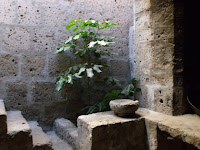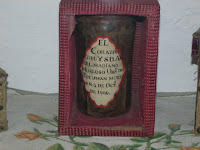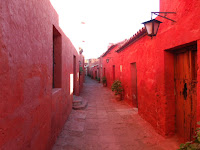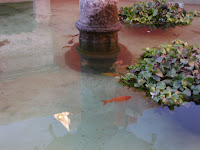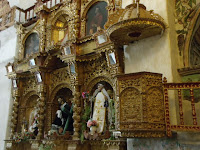One of the main attractions in Arequipa is the old Convent of Santa Catalina de Siena. Santa Catalina was built in the 16th century to accomodate the desire of the townsfolk of Arequipa for a convent in their city. Informed of thi wish during a visit, Viceroy Toledo, granted the necessary licenses for the establishment of a Dominican convent. A few years later, a young widow, Maria de Guzman, decided to take the vows and enter the nunnery, and in 1580 the convent was formally inaugurated and Maria named "the first inhabitant and prioress of said Monastery."
 For four centuries, Santa Catalina was community closed off from the rest of the world, enveloped in a mantle of silence and mystery, which contributed to both idealized imagining of life behind its walls and to lurid rumours. Pehaps each had some measure of truth. Santa Catalina, it is true, was a female-run world that lived by its own rules, laws and customs, dedicated to prayer and religious duty. On the other hand, many of the nuns came from wealthy families and sought to preserve their status and comforts within the convent's walls, bringing servants with them, building -or buying- large personal "cells" with sitting rooms, private kitchens, and running water, and continuing to wear jewelry and gold. One prioress, who tried to curb these practices, was the object of three separate poisoning attempts during her tenure!
For four centuries, Santa Catalina was community closed off from the rest of the world, enveloped in a mantle of silence and mystery, which contributed to both idealized imagining of life behind its walls and to lurid rumours. Pehaps each had some measure of truth. Santa Catalina, it is true, was a female-run world that lived by its own rules, laws and customs, dedicated to prayer and religious duty. On the other hand, many of the nuns came from wealthy families and sought to preserve their status and comforts within the convent's walls, bringing servants with them, building -or buying- large personal "cells" with sitting rooms, private kitchens, and running water, and continuing to wear jewelry and gold. One prioress, who tried to curb these practices, was the object of three separate poisoning attempts during her tenure!At its peak the convent housed some 400 women, about 180 of them being nuns, and the rest servants, slaves, young women boarded there for their education, and women who had been given asylum by the order. In the 1870s by order of the Pope, the servants and slaves were released, being given the choice of remaining and taking religious vows, or leaving the convent altogether.
Several dozen Dominican nuns still occupy a closed portion of the convent. However, earthquake damage in the 1960s led the nuns to construct new quarters at the north end of the convent, fitted now with electricity and running water -in accordance with municipal regulations- and the majority of the convent was largely restored to what it looked like in days past (although most of the upper stories and roof accesses are now long gone) and opened to public tours in 1970.
I have to honestly say that the convent was one of the more memorable places we visited. It is utterly fascinating to imagine the world that its walls must have encompassed, one little changed in the course of the centuries. A veritable city within the city, the 5 acre convent has streets,
plazas, fountains, a cemetery, and districts as any town would, as well as a hospital ward, a
laundry, and a communal kitchen. The frequent need for repairs has made
Santa Catalina a veritable catalogue of Arequipeno architectural styles
through time. I think we took more pictures there than at any other single site





